This is a continuation of a series of posts on the Fuji GFX 50S. You should be able to find all the posts about that camera in the Category List on the right sidebar, below the Articles widget. There’s a drop-down menu there that you can use to get to all the posts in this series; just look for “GFX 50S”. This is the third post in a series on the Fuji 250 mm f/4 lens for the GFX.
The target is a backlit razor blade (seen here with a different camera and lens):
The protocol:
- ISO 100
- Focus bracketing, both EFCS and ES options
- 50 steps
- Minimum step size (1)
- Delay set to 0
- Target distance, 2.5 and 5 meters
- Aperture exposure mode
- Wescott LED panels set to 5500 K.
- Gitzo legs
- Arca Swiss C1 head
- Vinyl tile flooring over 6 inches of concrete on grade
- Fast Raw Viewer to discard the really out of focus images
- dcraw in document mode to get raw planes
- MTF Mapper to compute MTF50
- Matlab to automate the above
- Excel to graphs the results
I’ll show you the results at 5 meters with the electronic shutter (ES) first. This is wide open:
The vertical axis is MTF50, measured in cycles per picture height (cy/ph). The shot taken with the lens focused to the closest position is on the left. There are 25 exposures plotted. There is no way to know the focused distance for these exposures. I used the minimum step size for the Focus Bracketing feature, which is about 2 micrometers CoC at the sensor plane (8 um sensor plane shift at f/4, and 22 um at f/11). If there were no longititudinal chromatic aberration (LoCA) all the curves would peak at the same place. As you can see, when the green channel peaks, the red channel is focused a little further away, and the blue channel a little closer. This amount of LoCA, while easily visible in the lab, is not likely to be bothersome in actual use.
Stopping down:
F/5.6 is the sharpest on-axis aperture.
At f/8, the depth of field is sufficient to cover up the LoCA.
This is excellent performance.
Using EFCS:
The results with EFCS are not as sharp as with the electronic shutter. I think they’d be closer if I set the delay to 3 or 4 seconds.
At 2.5m, with the electronic shutter on:
At f/5.6, the depth of field (DOF) is covering up the effects of the LoCA.
The performance at the closer distance is subtantially worse.
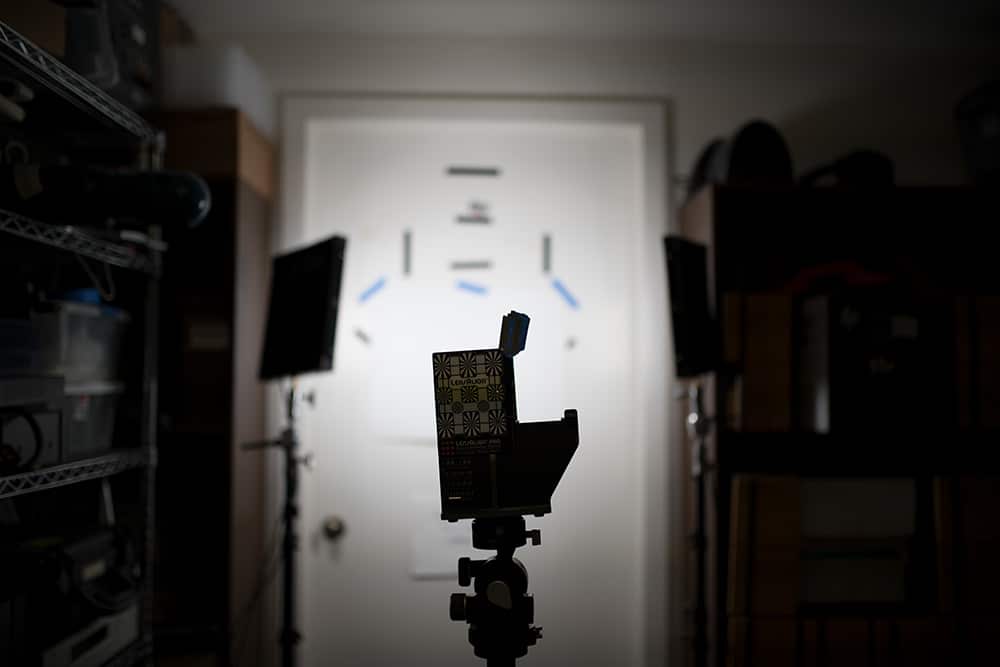
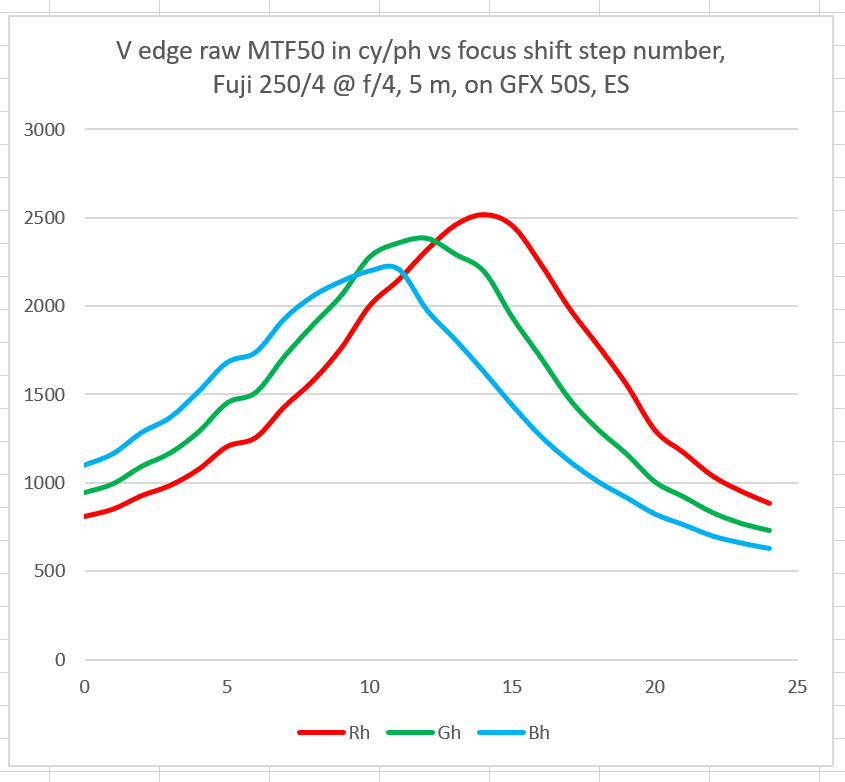
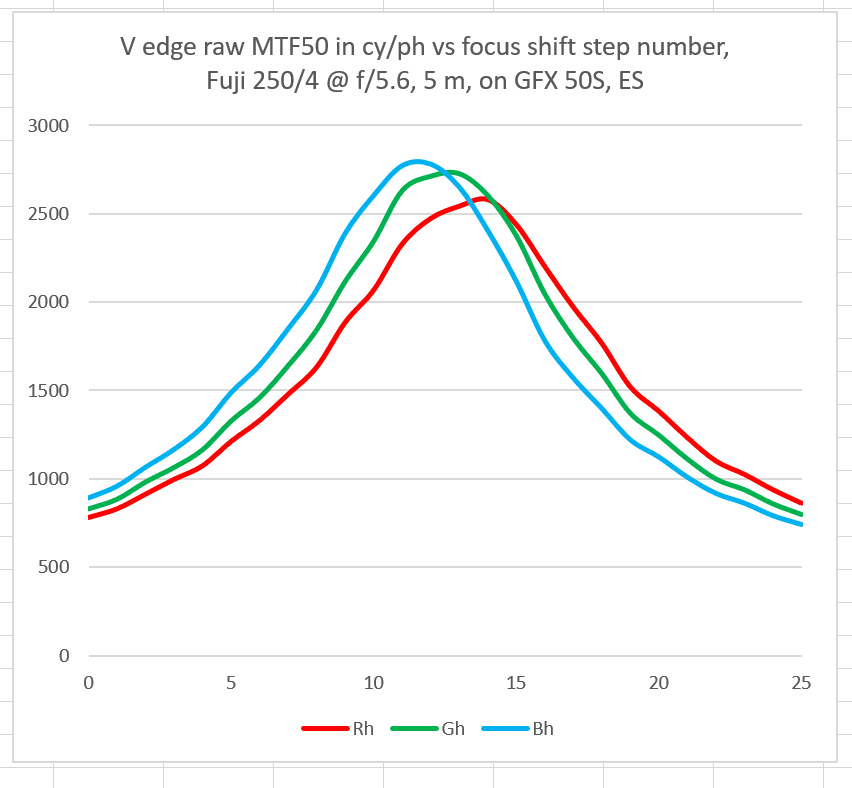
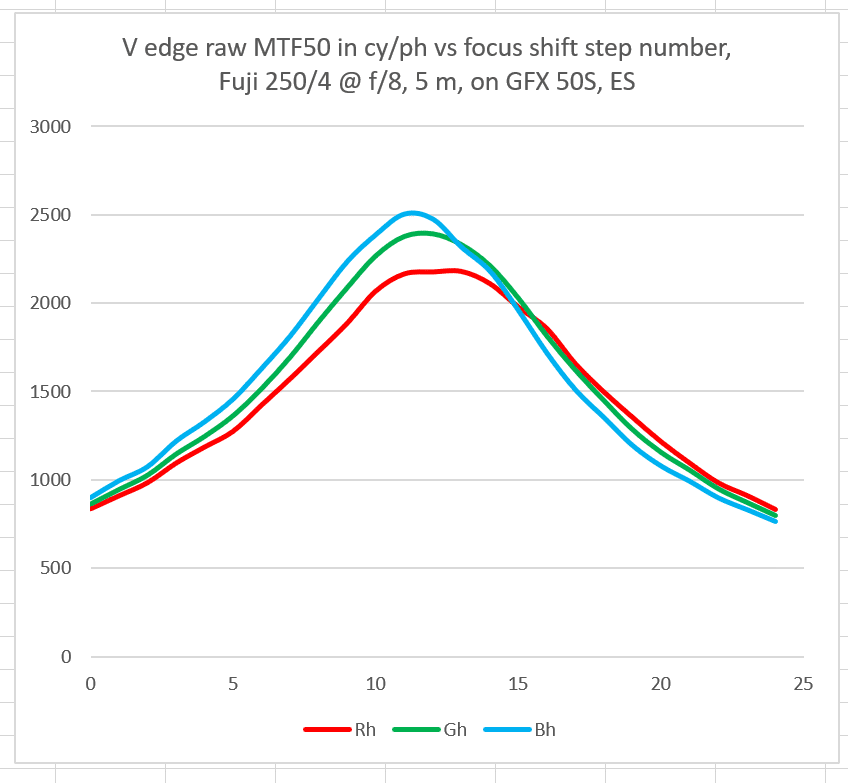
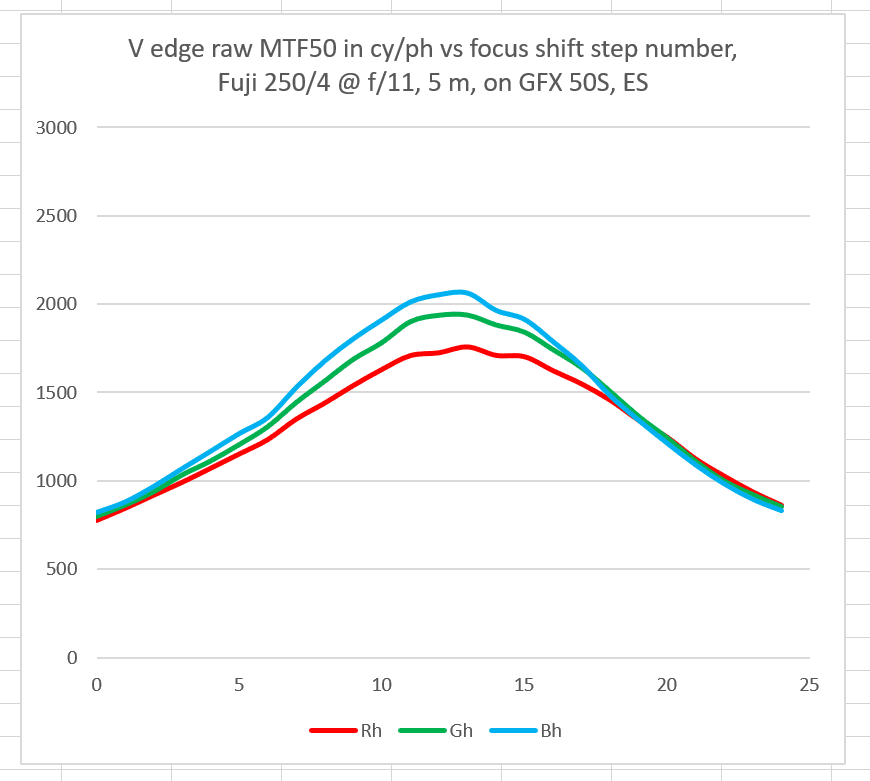
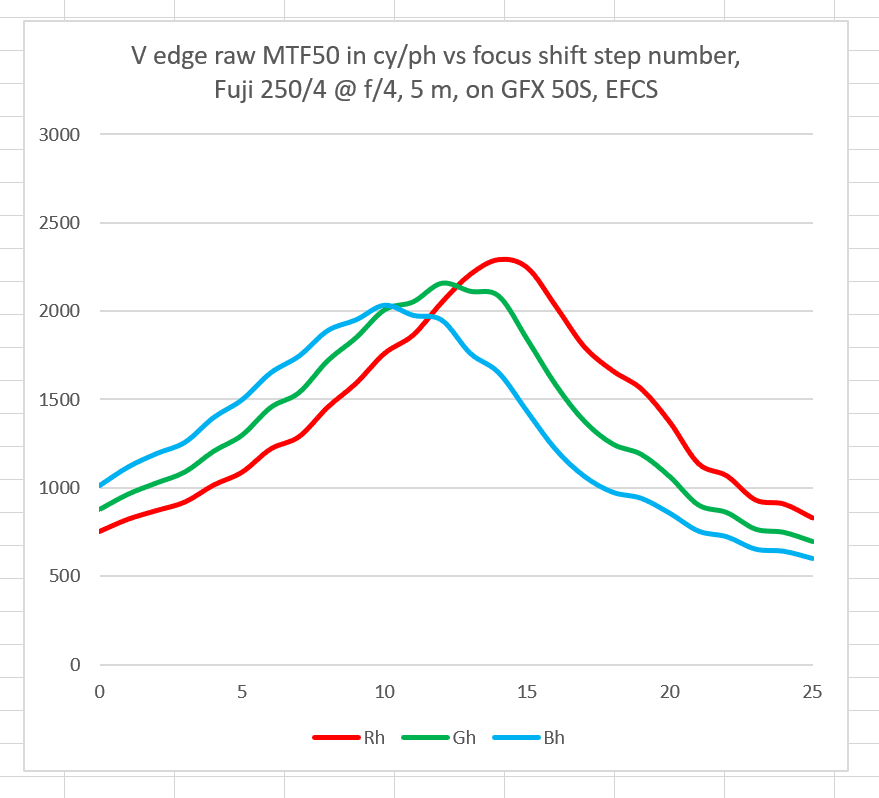
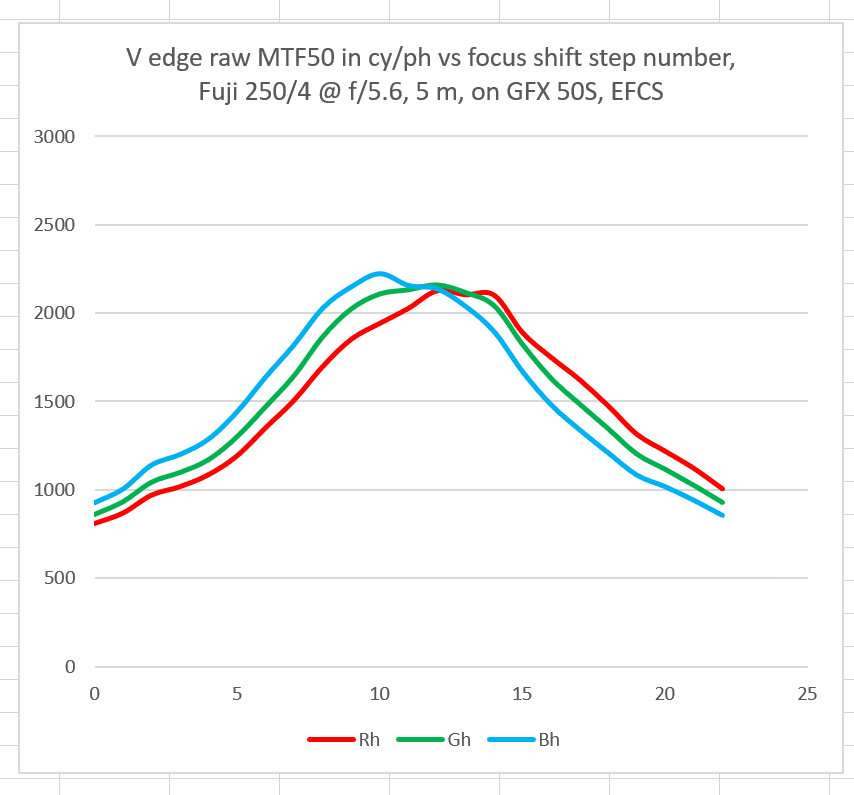
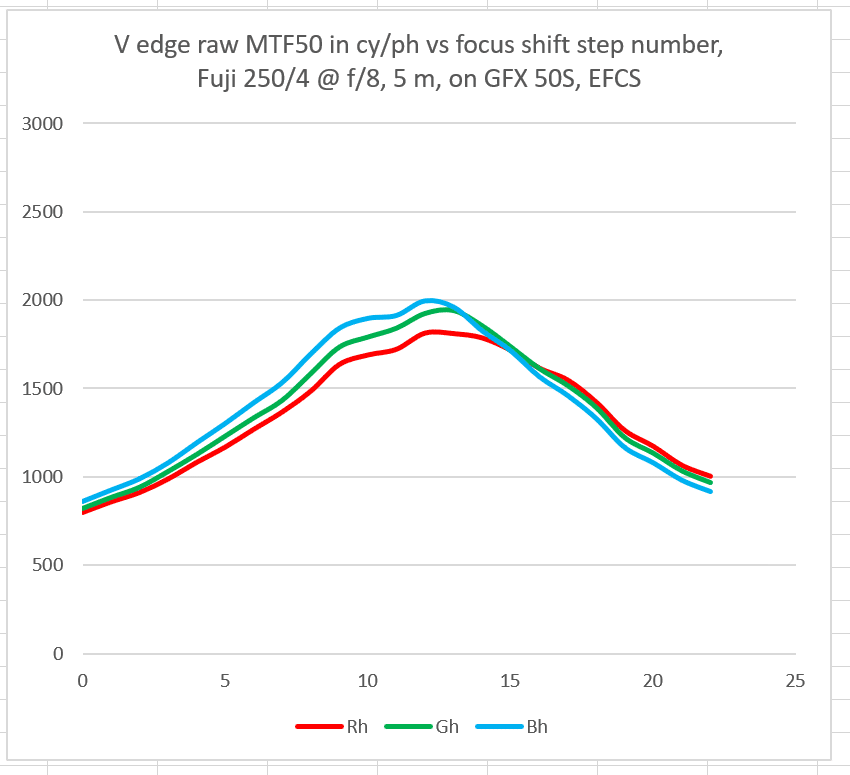
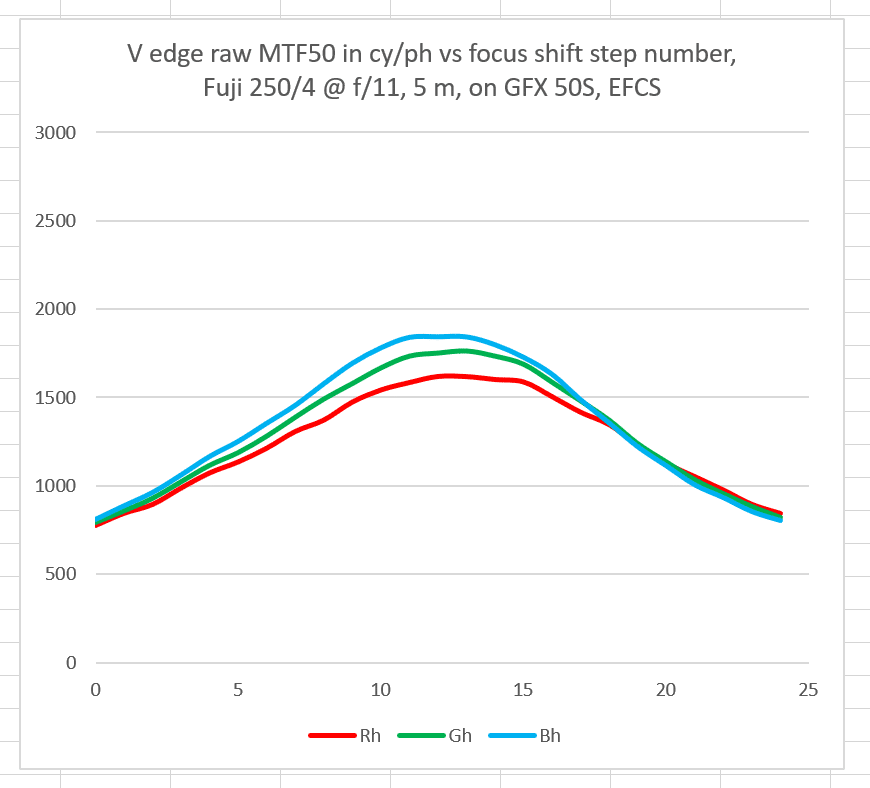
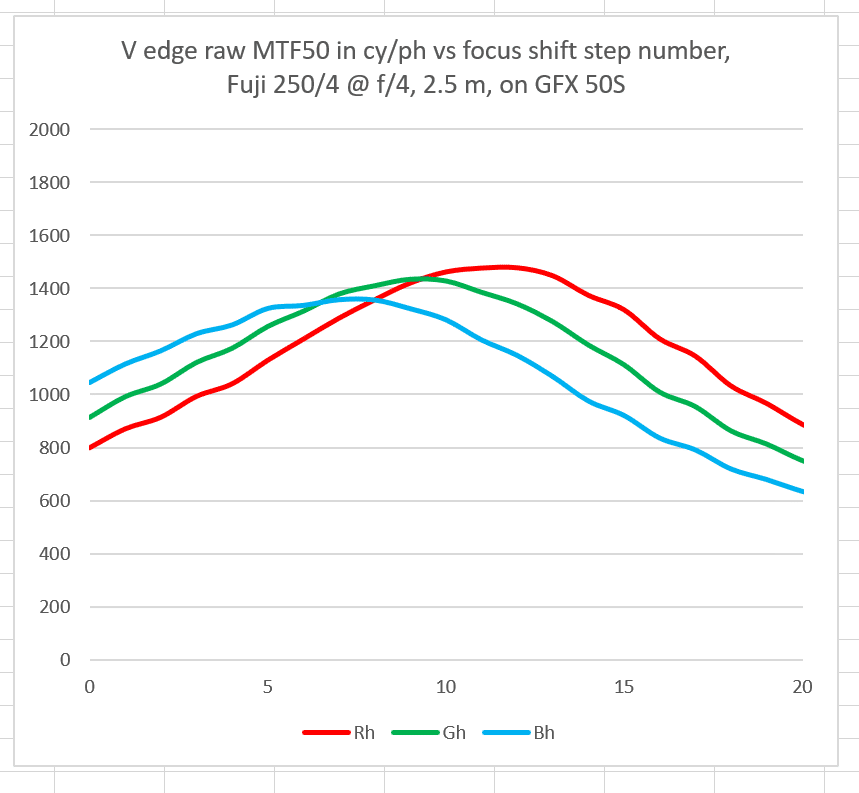
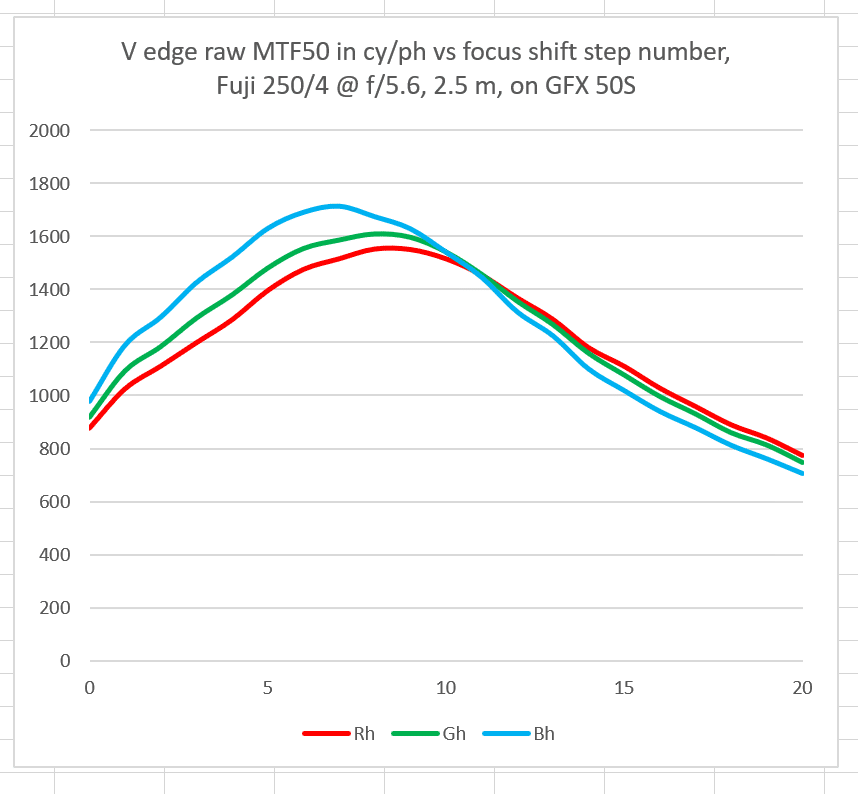
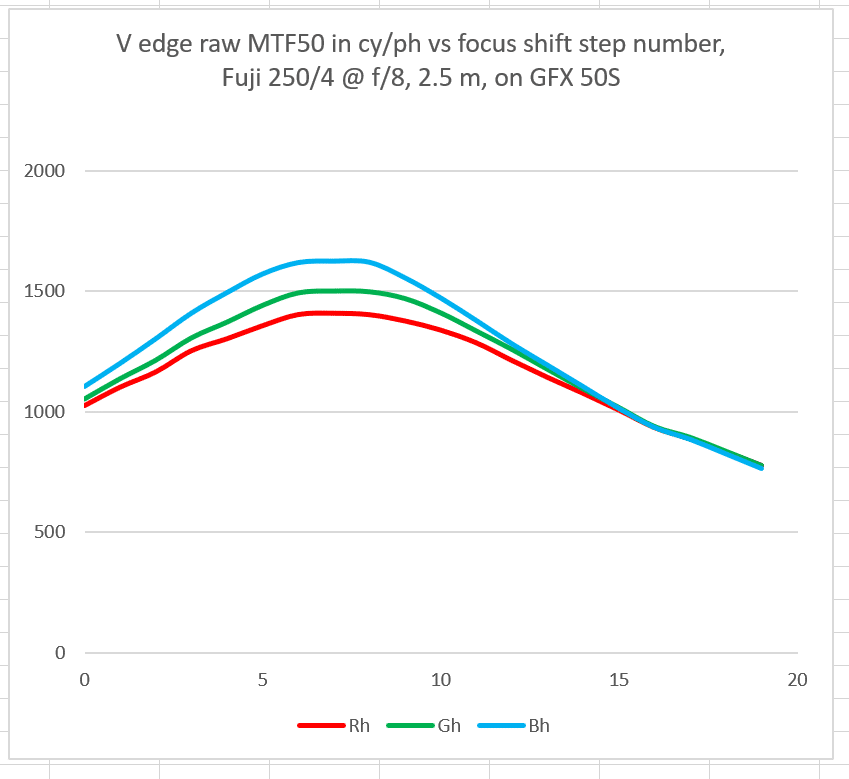
Gerd Peters says
Quote “The performance at the closer distance is subtantially worse.”
Hello Jim,
the near limit is still quite a distance away. I do not understand why the lens drops so much at a distance of 2.5m. Is there an explanation?
Greeting Gerd
JimK says
None that I can think of, except that the design is optimized for longer distances.
Cos says
Hi Jim,
Good to see the test appearing so soon after lens introduction. When Fuji announced the GF250mm lens and published its MTF charts on their website I thought it would be sharper compared to GF110mm.
In your tests, however, the opposite is true unless tests of these lenses are done differently by you.
https://blog.kasson.com/the-last-word/focus-shift-loca-of-fuji-1102-on-gfx/
Regards,
Cos
JimK says
By my testing, the 250 is very sharp, but not as sharp as the 110/2. The tests that you cite are comparable in that the target was the same, but I used a simplified technique for focus bracketing now that the GFX supports that in the camera’s firmware. This might result in missing the peak values by a tiny bit, and thus slightly lower numbers, but not by much. It is possible that the 250 might be sharper if I could have gotten farther away from the target. That is also true of the 110.
Unless otherwise specified, manufacturer’s MTF curves are measured (or, I believe, in Fuji’s case, simulated) at infinity.
Cos says
Yes, I see. Would it be possible to test both lenses at infinity using same protocol, e.g. manual focusing?
Regards,
Cos
JimK says
To do that, I’d need a very long computer controlled rail. To use bracketing, I’d need a new target.
Cos says
Hi Jim,
I just looked again at you GF110mm test protocol and realised that for GF110mm test you used manual focusing and for GF250mm focus bracketing. I am not sure to what extent this might have influenced the test results, if any.
Regards,
Cos
JimK says
I discussed that already. The focus bracketing technique might miss the peak by a little bit.
Cos says
Hi Jim,
Could you please estimate how big the focus bracketing steps were at different apertures in your GF250mm test. And would focus bracketing step accuracy have any influence in your test?
Regards,
Cos
JimK says
Steps are about 2 um CoC.
https://blog.kasson.com/gfx-50s/gfx-fw-3-0-focus-bracketing-with-the-120-4-macro/
Pixel pitch is 5.3 um. So there could be some small missing of the actual peaks.
Gerd Peters says
Hello Jim,
my 250mm incl. 1.4 tele converter has arrived today with me. I would like to take up the subject of power loss at 2.5m again.
I bought the lens for landscape shots and made corresponding test images.
Example: lower part of the image 50% fields and meadows, middle part of the image 35% forest, upper part of the image 25% sky – at ISO 100, F11, 100 / s – focus in the middle of the forest (on a wood heavy-duty tripod from Berlebach with C1 head) ,
In the test images, the lower part of the picture is sharper than 30% higher in the picture, the forest is then sharper again and of course you can not see it in the sky. I initially believed in decentring, but it looks more like a distance plane – but I’m still unsure. You can see it in the 100% view. I have the feeling with the lens is generally not something.
My lens seems to be mechanically, electrically okay. All functions do exactly what they should. My question to you: Could you please make a landscape with the 250mm with the highest possible depth of field at. F11 and see if you also find strange levels of sharpness.
What I can definitely say, the 250mm delivers much worse contrasts. I thought it was weird in the beginning, the Provia default profile looks very slow – which is atypical. Then I made a comparison with the 110mm. This looks like I’m using a pole filter on the 110mm and not on the 250mm. At the same time I measured the ambient light with the C700. Since both pictures have changed almost nothing (only 4 Kelvin – Lux and CRI values are the same).
Greeting Gerd
PS: the 110mm is much sharper in practice than the 250mm
JimK says
Take a look here:
https://blog.kasson.com/gfx-50s/fuji-250-4-defocusing-behavior/
Have you run my Siemens Star test on your lens?
Gerd Peters says
Hello Jim,
Thank you for your effort and the information.
I think I found the problem today when performing the Siemensstern test.
It’s probably a broken OIS switch on the lens. Although he is physically off, he seems to work and provides the following EXIF data – ImageStabilization: Optical; On (mode 1, continuous); 0
Today I had very different results on the tripod and assume that the broken OIS switch has caused my problem.
I’m in the FPS program and call tomorrow – see what they say.
But what remains – subjectively delivers the 250mm worse contrast / significantly fluffier colors than the other Fuji GF lenses I have (23mm, 45mm, 110mm). I can already see the difference in the viewfinder. What I do not know, of course, whether the firmware adjusts the other lenses accordingly, whether the RAW’s in the firmware for the other lenses are better pre-baked or whether the 250mm actually delivers worse contrast / faint colors. It is not a broken leg you can adjust it in the RAW converter again accordingly. But your “subjective” opinion would really interest me if you also see these differences to your other Fuji lenses.
Greeting Gerd